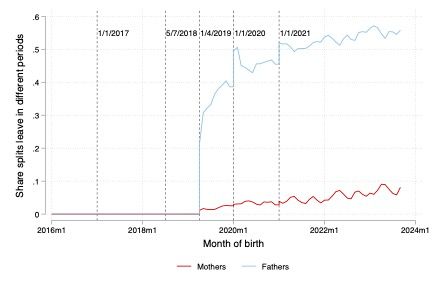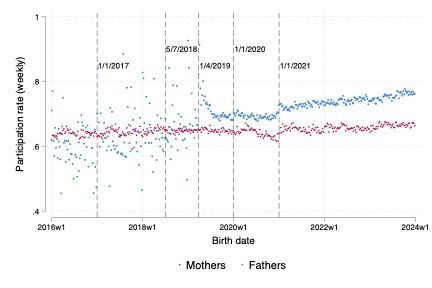
Use-it-or-lose-it paternity leave with full pay is changing norms in Spain.
@claudiahupkau.bsky.social @lidiafarre.bsky.social @libertadgonzalez.bsky.social Jenifer Ruiz-Valenzuela
In CentrePiece magazine
Read:
@claudiahupkau.bsky.social
Associate Professor of Economics, CUNEF Universidad Madrid

Use-it-or-lose-it paternity leave with full pay is changing norms in Spain.
@claudiahupkau.bsky.social @lidiafarre.bsky.social @libertadgonzalez.bsky.social Jenifer Ruiz-Valenzuela
In CentrePiece magazine
Read:
Thanks to my amazing coauthors
@libertadgonzalez.bsky.social , @lidiafarre.bsky.social and Jenifer Ruiz-Valenzuela! 🙌
📘 In summary:
Spain’s reforms offer a compelling case for how policy can change behavior - fast.
And they raise big questions for countries still treating paternity leave as optional or symbolic.
Full paper 👉 cep.lse.ac.uk/_NEW/PUBLICA...
@EconTwitter @GenderEcon #EconTwitter
👨👧👦 What are the broader implications?
Evidence on short-run labor market effects is mixed.
But there’s growing hope that paternity leave may shift long-term gender norms, reduce the child penalty, and promote care equality — if properly designed.
The Spanish case suggests that policy design matters.
Three key features stand out:
✔️ Mandatory initial weeks
✔️ Equal duration for fathers and mothers
✔️ No shared/transferable leave (only earmarked)
📊 Leave splitting is more common in certain sectors and less frequent in others; high earners are also more likely to split their leave.
Access to flexibility and job protection still reflects inequality.
⏳ We also see rising use of part-time leave (from 3% in 2019 to 7.1% in 2023).
Flexibility matters — and fathers are increasingly tailoring leave to family needs.

Share of mothers/fathers splitting their leave into two or more seperate periods.
🔀 More than half of fathers now split their leave, taking time off in two or more separate periods.
This was non-existent in 2018.
Splitting likely allows fathers to be home after mothers return to work, helping delay the transition to formal childcare.

Evolution of average leave of maternity and paternity leave taken by month of birth of the child.
⏱️ Fathers also take nearly the full 16 weeks available.
After each extension, they immediately adjusted.
Our DiD estimates show significant jumps in leave duration after every reform — a strong behavioral response.

The chart shows the number of maternity/paternity leave permits commenced per week divided by the number of births per week from 2016 to 2023.
📈 Participation rate among fathers rose from 46% in 2016 to 75% by 2023.
As the graph shows, since 2019, when some weeks of leave became mandatory, a higher share of fathers is taking leave than mothers. Why? Because of strong eligibility gaps (mothers work < than fathers).

Evolution of paternity and maternity leave legislation in Spain
🇪🇸 Spain is unique in Europe. Since 2019, it has made part of paternity leave compulsory — starting with 2 weeks, rising to 6.
Today, fathers get 16 weeks of paid, non-transferable leave, the same as mothers.
And this isn’t just on paper. Fathers are taking it.
🚼 What if making paternity leave mandatory could actually move the needle on gender equality?
In a new working paper, we study Spain’s paternity leave reforms from 2017 to 2021 — and the effects are remarkable.
📄 cep.lse.ac.uk/_NEW/PUBLICA...

‼️Call for Papers: III Spanish Workshop on Development Economics
🌆 October 21-22nd at @fundacionareces.bsky.social dacionareces.bsky.social in Madrid!
⭐Wonderful keynote speakers: Sylvie Lambert and Raul Sanchez de la Sierra
📝Full papers/extended abstracts by June 15: spande.workshops@gmail.com.
It was a pleasure attending this Workshop and a privilege meeting the speakers and discussing family policies with them!
01.04.2025 20:54 — 👍 3 🔁 0 💬 0 📌 0At @cunef.bsky.social we’re super agile in that respect! I’ll make sure to mention it to applicants in Job Market interviews.
27.11.2024 09:36 — 👍 1 🔁 0 💬 0 📌 0Welcome @lidiafarre.bsky.social to @bsky.app 😍
27.11.2024 08:55 — 👍 2 🔁 0 💬 0 📌 0I recommend you reading the new IEB report on gender equality in the labor market: ieb.ub.edu/en/publicati... Three great authors plus myself discuss the evidence on policies to reduce inequality! Check it out.
26.11.2024 11:44 — 👍 3 🔁 0 💬 1 📌 1This is my first post here and just wanted to say! Thanks to those who followed me back! I’ll soon start posting more interesting stuff!
18.11.2024 17:35 — 👍 6 🔁 0 💬 0 📌 0